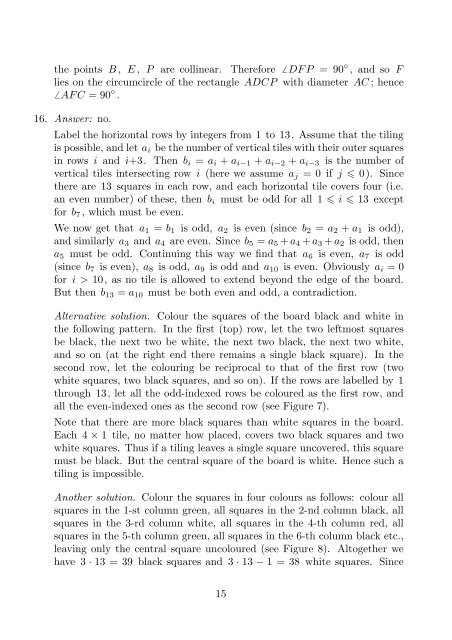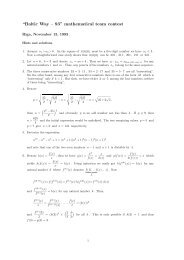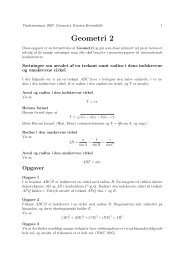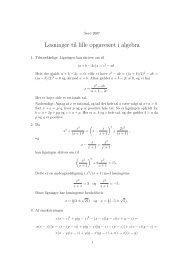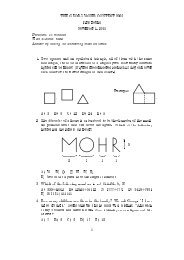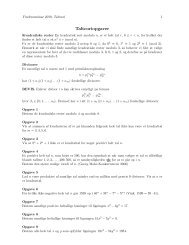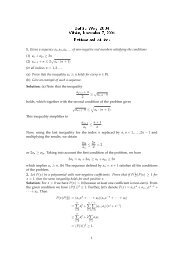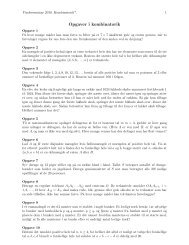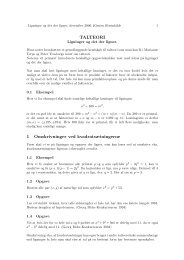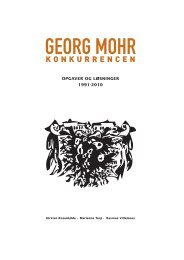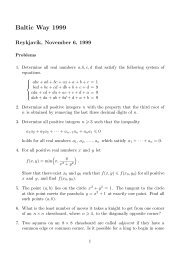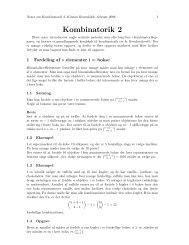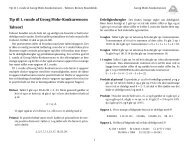You also want an ePaper? Increase the reach of your titles
YUMPU automatically turns print PDFs into web optimized ePapers that Google loves.
the points B , E , P are collinear. Therefore � DF P = 90 ◦ , and so F<br />
lies on the circumcircle of the rectangle ADCP with diameter AC ; hence<br />
� AF C = 90 ◦ .<br />
16. Answer: no.<br />
Label the horizontal rows by integers from 1 to 13. Assume that the tiling<br />
is possible, and let ai be the number of vertical tiles with their outer squares<br />
in rows i and i+3. Then bi = ai + ai−1 + ai−2 + ai−3 is the number of<br />
vertical tiles intersecting row i (here we assume aj = 0 if j � 0). Since<br />
there are 13 squares in each row, and each horizontal tile covers four (i.e.<br />
an even number) of these, then bi must be odd for all 1 � i � 13 except<br />
for b7 , which must be even.<br />
We now get that a1 = b1 is odd, a2 is even (since b2 = a2 + a1 is odd),<br />
and similarly a3 and a4 are even. Since b5 = a5 + a4 + a3 + a2 is odd, then<br />
a5 must be odd. Continuing this way we find that a6 is even, a7 is odd<br />
(since b7 is even), a8 is odd, a9 is odd and a10 is even. Obviously ai = 0<br />
for i > 10, as no tile is allowed to extend beyond the edge of the board.<br />
But then b13 = a10 must be both even and odd, a contradiction.<br />
Alternative solution. Colour the squares of the board black and white in<br />
the following pattern. In the first (top) row, let the two leftmost squares<br />
be black, the next two be white, the next two black, the next two white,<br />
and so on (at the right end there remains a single black square). In the<br />
second row, let the colouring be reciprocal to that of the first row (two<br />
white squares, two black squares, and so on). If the rows are labelled by 1<br />
through 13, let all the odd-indexed rows be coloured as the first row, and<br />
all the even-indexed ones as the second row (see Figure 7).<br />
Note that there are more black squares than white squares in the board.<br />
Each 4 × 1 tile, no matter how placed, covers two black squares and two<br />
white squares. Thus if a tiling leaves a single square uncovered, this square<br />
must be black. But the central square of the board is white. Hence such a<br />
tiling is impossible.<br />
Another solution. Colour the squares in four colours as follows: colour all<br />
squares in the 1-st column green, all squares in the 2-nd column black, all<br />
squares in the 3-rd column white, all squares in the 4-th column red, all<br />
squares in the 5-th column green, all squares in the 6-th column black etc.,<br />
leaving only the central square uncoloured (see Figure 8). Altogether we<br />
have 3 · 13 = 39 black squares and 3 · 13 − 1 = 38 white squares. Since<br />
15


